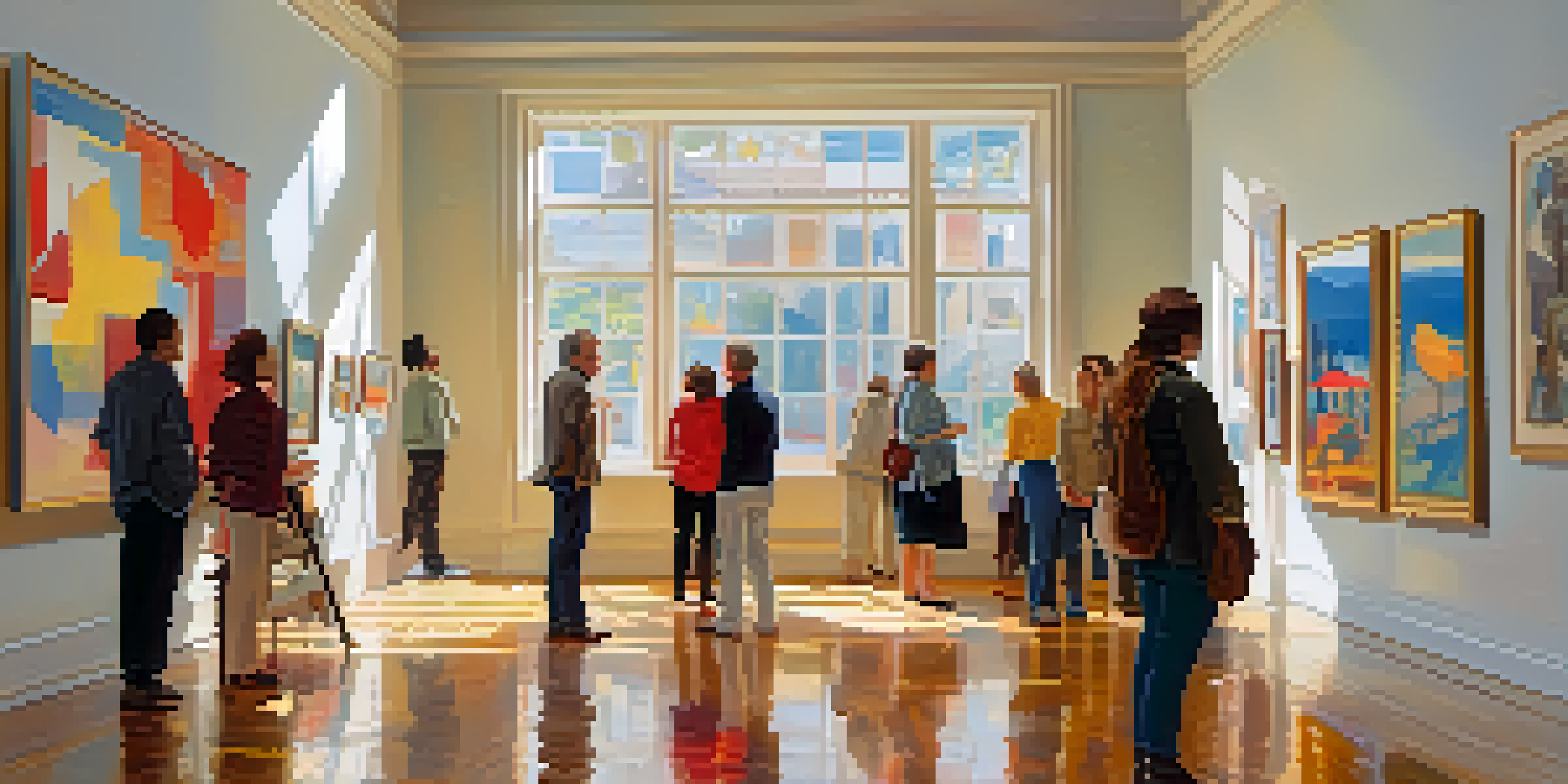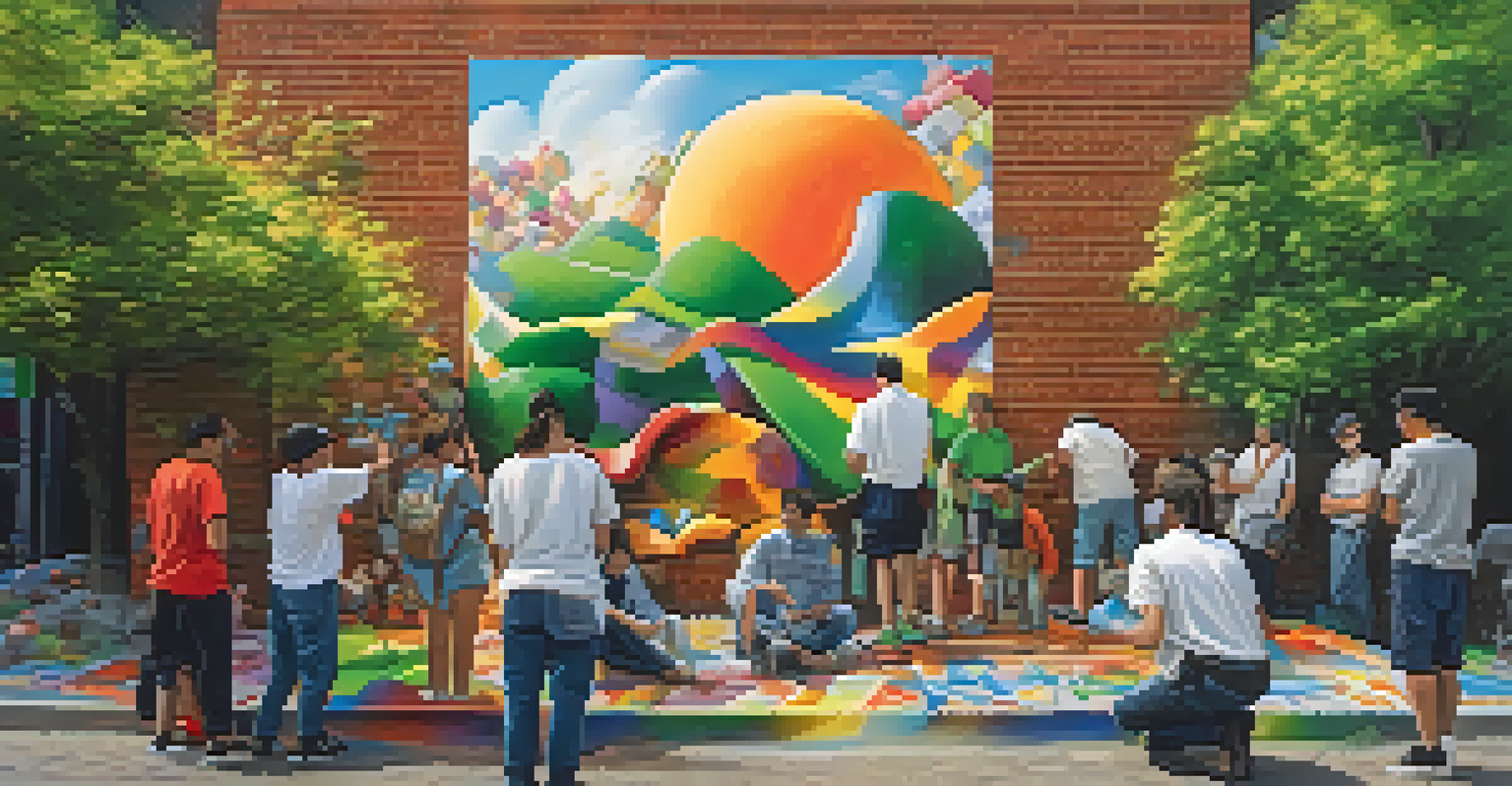The Concept of Art as a Commodity: Market Influence on Value

Understanding Art as a Commodity in Today’s Market
In the contemporary landscape, art is often viewed through the lens of commerce, transforming it into a commodity. This shift means that the value of art is not solely based on its aesthetic or cultural significance but also on market demand and trends. Just like stocks, the worth of an artwork can fluctuate based on buyers' interests, making it a fascinating subject for both artists and collectors alike.
Art is not a commodity; it is a way of life.
Consider the rise of street art, which was once dismissed but has now become highly sought after. Artists like Banksy have seen their works explode in value as they gain popularity, reflecting how market dynamics can elevate a piece from obscurity to a prized possession. This illustrates that the perception of value can be as subjective as beauty itself.
Ultimately, understanding art as a commodity allows us to appreciate the complex interplay between creativity and commerce. While many artists strive for authenticity in their work, they also navigate the pressures of a market that can dictate their success. This duality raises essential questions about the nature of art and its role in society.
Historical Context: Art’s Journey to Commodification
To grasp the current state of art as a commodity, we must look back at its historical journey. Traditionally, art was created for religious or cultural purposes, with value rooted in spiritual or community significance rather than monetary gain. Over time, especially during the Renaissance, the emergence of the art market began to change this perspective, as collectors sought to acquire pieces for personal status and investment.

The 20th century marked a turning point with the rise of modernism, where art became more accessible and diverse. Movements like Dada and Surrealism challenged the norms, and suddenly, art was not just for the elite. This democratization led to an increased interest in art as an investment, making it a commodity in the eyes of the public and collectors alike.
Art's Value Shaped by Market Forces
The worth of art today is heavily influenced by market demand, trends, and the dynamics of commerce.
Today, the legacy of this commodification can be seen in auction houses and galleries that treat art as high-value assets. As art becomes increasingly intertwined with finance, it raises questions about authenticity and the true purpose of artistic expression. Are artists creating for passion, or are they also motivated by the potential financial payoff?
The Role of Galleries and Auction Houses in Valuation
Galleries and auction houses play a significant role in determining the market value of art. They curate collections and promote artists, influencing how potential buyers perceive worth. This means that the marketing strategies employed by these institutions can greatly affect an artwork's price, often leading to inflated valuations driven by hype rather than intrinsic merit.
The artist is nothing without the gift, but the gift is nothing without work.
For example, when a piece is showcased at a renowned gallery or auctioned at Christie's, it gains visibility that can skyrocket its price. Collectors often associate the prestige of these venues with higher value, which creates a cyclical effect where demand drives prices up. However, this raises a critical question: is the price reflective of artistic value or simply market manipulation?
Furthermore, the role of art dealers and consultants cannot be overlooked. They often guide collectors on what to buy, shaping trends and preferences within the market, which further complicates the landscape. This interconnected web of influence highlights the complexities of art valuation and challenges the notion of objective worth.
The Impact of Social Media on Art Valuation
In recent years, social media has revolutionized how art is perceived and valued. Platforms like Instagram have given artists a direct line to audiences, allowing them to cultivate followings and engage with fans. This accessibility means that art can gain traction and visibility in ways that were previously unimaginable, sometimes leading to skyrocketing prices based on online popularity.
Consider the rise of digital art and NFTs (non-fungible tokens), which have taken the art world by storm. Artists can now sell their work directly to consumers, bypassing traditional gatekeepers and potentially increasing their earnings. This shift not only democratizes the art market but also creates a new layer of complexity in how art is valued, as digital scarcity becomes a factor.
Social Media Transforms Art Sales
Platforms like Instagram and the rise of NFTs have revolutionized how art is marketed and valued, creating both opportunities and challenges for artists.
However, this trend also has its pitfalls. The rapid nature of social media can lead to trends that fade as quickly as they appear, leaving some artists and collectors in uncertain waters. As the market fluctuates based on viral moments, the challenge lies in discerning lasting value from fleeting popularity.
Celebrity Influence: Branding and Art Value
Celebrity culture has a profound impact on the art market, often influencing how value is perceived. When a celebrity endorses an artist or a specific piece, it can propel that artwork’s value into the stratosphere. This phenomenon showcases how fame and branding can overshadow artistic merit, turning art into a status symbol rather than a genuine expression.
For instance, when celebrities like Jay-Z or Rihanna purchase or promote art, they not only validate the artist but also elevate the market value of their work. This trend can create a ripple effect, where other collectors feel compelled to invest in pieces associated with high-profile figures. It raises a crucial question: does this practice dilute the essence of art, reducing it to mere trend-chasing?
Moreover, this celebrity influence extends beyond purchasing art; it shapes public perception and desirability. As collectors and fans associate certain artists with fame, the market can shift dramatically, driven by popular opinion rather than artistic integrity. This intersection of art and celebrity culture reflects broader societal values and presents an ongoing challenge for artists seeking to maintain authenticity.
The Ethics of Art as a Commodity: A Double-Edged Sword
The commodification of art raises ethical questions that are hard to ignore. On one hand, it provides artists with financial opportunities that can support their careers. On the other hand, it can lead to exploitation and a focus on marketability over creativity. This duality highlights the complexities artists face in navigating a system that often prioritizes profit over passion.
Consider emerging artists who may feel pressured to conform to market trends to achieve success. This can stifle creativity and lead to a homogenization of art, where unique voices are drowned out by commercial demands. The struggle between maintaining artistic integrity and achieving financial stability presents a significant challenge in the current landscape.
Ethics in Art Commodification
The commodification of art raises ethical concerns about creativity versus marketability, impacting artists' integrity and access to opportunities.
Furthermore, the growing art market can also perpetuate inequalities, as access to resources and opportunities is often limited to a privileged few. This raises critical discussions about who gets to participate in the art world and who benefits from its commodification. As we reflect on these ethical implications, it's essential to advocate for a more inclusive and equitable art community.
The Future of Art Valuation: Trends and Predictions
As we look to the future, the intersection of art and commerce is likely to evolve further. Emerging technologies, such as blockchain and virtual reality, are poised to reshape how art is created, sold, and valued. These innovations could democratize access to art and provide new avenues for artists to connect with audiences and collectors alike.
Moreover, the growing emphasis on sustainability and social impact is expected to influence art valuation. Collectors increasingly seek works that align with their values, favoring artists who prioritize ethical practices and community engagement. This shift could lead to a redefinition of value, where the story behind the art becomes just as important as the piece itself.

Ultimately, the future of art as a commodity will likely be shaped by ongoing dialogues about authenticity, accessibility, and ethical considerations. As artists, collectors, and the public navigate this landscape, it will be crucial to foster a culture that values both artistic expression and market dynamics. By embracing these complexities, we can ensure that the art world remains vibrant and diverse.